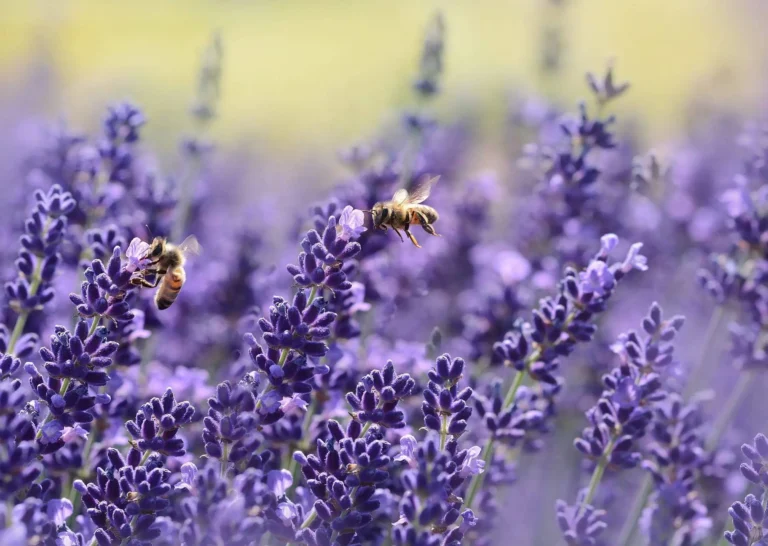Citronella Essential Oil

Lavender Essential Oil
Lavender True (Lavandula angustifolia)
Plant Family: Labiatae
Synonyms
Common Lavender, English Lavender, Spike Lavender, Stoechas Lavender
Origin
An aromatic shrub native to Mediterranean region, lavender has a long history of use as a medicine, fragrance and insect repellent. The essential oil production is long-established in the Provence region of France and also occurs in Spain, Bulgaria and many other countries.
Extraction Method
Lavender oil is steam- or water distilled from fresh flowering tops of the plant. It is necessary up to 100 kg of fresh Lavender raw to obtain 1 kg of essential oil.
Nature of the Oil
A colourless or pale yellow liquid, lavender oil has a very familiar, fresh, floral, slightly harsh and sweet smell which refreshes, relaxes, and generally is therapeutic.
Perfumery Note – Middle. The aroma lasts 2 to 3 days.
Lavender scent is reminiscent of the flowers from which it is extracted and can be described as being feminine, subtle, modest, romantic, and even poetic. It is sweet-smelling and create a feeling of cheerfulness. Floral scent is considered to be classic and timeless.
Main Constituents
| Linalyl acetate | 25.0 -47.0% |
| Linalool | 20.0 -43.0% |
| Limonene | 0.0 -1.0% |
| 1,8-Cineole | 0.0 – 3.0% |
| Cis-b-Ocimene | 1.0 – 10.0% |
| Trans-b-Ocimene | 0.5 – 6.0% |
| 3-Octanone | 0.0 –3 .0% |
| Camphor | 0.0 –1 .5% |
| Terpinen -4-ol | 0.0 – 8.0% |
| Lavandulyl acetate | 0.0 – 8.0% |
| Lavandulol | 0.0 – 3.0% |
| alpha-Terpineol | 0.0 – 2.0% |
| p-Cymene | 0.0 -0.2% |
Properties
Analgesic, anticonvulsive, antidepressant, antimicrobial, antirheumatic, antiseptic, antispasmodic, antitoxic, carminative, cholagogue, cicatrisant, cordial, cytophylactic, deodorant, diuretic, emmenagoguic, hypotensive, insecticidal, nervine, parasiticidal, rubefacient, sedative, sudorific, tonic, vermifugal, vulnerary.
Therapeutic Properties
This is the most versatile and well-used of all the essential oils, its lack of toxicity making it a valuable remedy for everyday use. It may be used in massage blends, bath oils, room fragrancing, compresses, douches and steam inhalations, and is one of the few essential oils that may be applied to the skin without dilution.
Lavender is a balancing or regulating oil. In the long run it does tend towards sedating or calming, although initially it has a reviving effect — a footbath with a few drops of lavender added has one of the most restorative effects imaginable. Like jasmine, it can be used to treat any physical symptoms that are the result of stress or nervous tension.
Lavender is relaxing as it calms cerebro-spinal activity. It may be used to treat irritability, depression, insomnia, hysteria, shock and nervous tension. It also has mild analgesic properties, which make it an important oil in the treatment of headaches and migraine, and good for all forms of neuralgia, shingles, sciatica, muscular pains and rheumatism. It will relieve earache in children; massage a few drops around the ear.
Its restorative and calming effect on the heart means that it is helpful for high blood pressure and palpitations — use it in massage and bath preparations, and as an inhalant to relieve fainting and shock.
The antispasmodic properties of lavender make it efficacious in the treatment of any kind of spasmodic cough. The excellent antiseptic properties are effective in treating flu, bronchitis and pneumonia.
Aromatherapeutic Uses
Skin care (most skin types), acne, allergies, athlete’s foot, boils, bruises, eczema, dandruff, dermatitis, burns, chilblains, psoriasis, ringworm, scabies, insect bites and stings, as an insect repellent, asthma, earache, coughs, colds and ‘flu, catarrh, laryngitis, nausea, colic, cystitis,
painful menstruation, depression, headache, insomnia, migraine, nervous tension, pre-menstrual syndrome, stress-related disorders.
Psychological Profile
If you are sensitive person who is easily embarrassed and inhibited you need lavender. You may have learnt to conceal your shyness by appearing to be efficient, practical and organized, yet behind this you are aware of your sensitivity and vulnerability to other peaople. Using lavender will help you to accept your sensitivity and make the most of new situations that so often leave you feeling frustrated and unable to express yourself.
Blends Well With
Essential oils of Bergamot and other citrus, Cedarwood, Clove, Clary sage, Coriander, Cypress, Frankincense, Geranium, Juniper, Myrrh, Pine, Rose, Rosemary, Sandalwood, Ylang Ylang.
Our safety advice
The dermal maximum of 0.1 % is based on the 0.12% found by Bouhlal et al (I 988b) to be the highest concentration producing no adverse skin reactions.
Cautions
Generally regarded as non-irritant and non-sensitising. However, there are reports of contact dermatitis as a result of over-use of the oil, especially amongst aromatherapists themselves. It is also possible to be sensitive to one particular brand of lavender oil and not to another, even though both types may be labelled ‘L. officinalis’. This may suggest that the oil has been adulterated or that it has oxidised. The oil is much more likely to irritate skin when used neat or in high concentrations.
Other varieties
Lavender used to be subject to extensive adulteration, but now lavandin and spike lavender are used instead of lavender in soaps, household goods and cheaper perfumes, leaving lavender for therapeutic use and the better quality perfumes. Unfortunately it is still adulterated with lavandin (as demand is always greater than supply) and a true lavender should be bought from someone who knows the source – and sometimes even the farmer!
References
1. C. Wildwood “The Encyclopedia of Aromatherapy”, Vermont, Healing Arts Press, 1996
2. R. Tisserand, R. Young, E. M Williamson “Essential Oil Safety. A Guide for Health Care Professionals”, Churchill Livingstone ELSEVIER, 2014
3. S. Curtis “Essential Oils”, AURUM, London, 1996
4. R. Balz “The Healing Power of Essential Oils”, LOTUS LIGHT SHANGRI-LA, Twin Lakes, 1996
5. Л.ГДудченко, Г.П.Потебня, Н.А.Кривенко «Ароматерапия и аромамасаж», «Максимум», Киев, 1999
